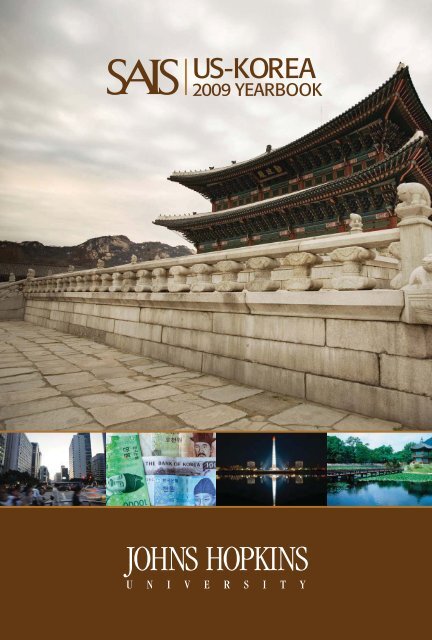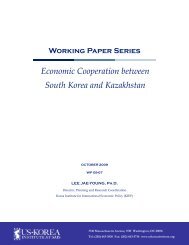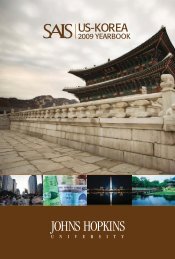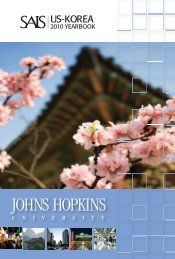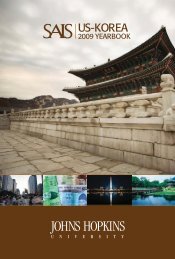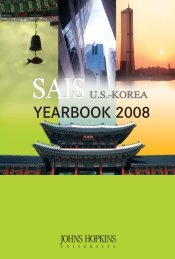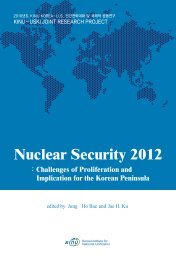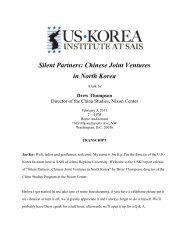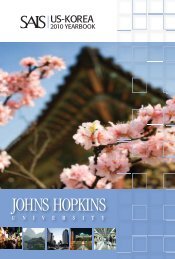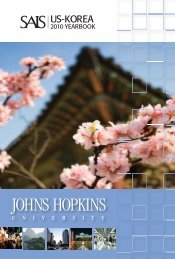US-Korea Institute at SAIS
US-Korea Institute at SAIS
US-Korea Institute at SAIS
- No tags were found...
You also want an ePaper? Increase the reach of your titles
YUMPU automatically turns print PDFs into web optimized ePapers that Google loves.
<strong>US</strong>-KOREA<br />
2009 YEARBOOK
South <strong>Korea</strong>-China Mutual Perceptions: The Good, The Bad, and The Ugly<br />
SOUTH KOREA-CHINA MUTUAL PERCEPTIONS:<br />
THE GOOD, THE BAD, AND THE UGLY<br />
By Tze Chin “Alvin” Wong<br />
I. INTRODUCTION<br />
China’s and South <strong>Korea</strong>’s bil<strong>at</strong>eral political and economic rel<strong>at</strong>ions have<br />
developed dram<strong>at</strong>ically since the normaliz<strong>at</strong>ion of diplom<strong>at</strong>ic ties in 1992.<br />
China’s and South <strong>Korea</strong>’s leaders had effective political cooper<strong>at</strong>ion in bil<strong>at</strong>eral<br />
and multil<strong>at</strong>eral settings, such as ASEAN 10+3 and China-Japan-South <strong>Korea</strong><br />
tril<strong>at</strong>eral conferences; China and South <strong>Korea</strong> share a confluence of interests in<br />
regional security, such as the Six-Party Talks on the North <strong>Korea</strong>n nuclear issue.<br />
Indeed, China and South <strong>Korea</strong> have shared a consensus engagement of North<br />
<strong>Korea</strong> compared to other parties such as the United St<strong>at</strong>es and Japan, especially<br />
on the need to supply aid to DPRK and the aversion to apply sanctions. Since<br />
1992, trade and economic ties have mushroomed and formed the firm found<strong>at</strong>ion<br />
for bil<strong>at</strong>eral rel<strong>at</strong>ions. In view of this strong political and economic rel<strong>at</strong>ionship,<br />
China and South <strong>Korea</strong> have developed extensive people-to-people exchanges,<br />
with tourism, educ<strong>at</strong>ion, and culture flourishing since then. However, irritants<br />
and friction reflected in disputes over trade rel<strong>at</strong>ions, historical issues, territorial<br />
sovereignty, and cultural ownership, emerged over this period as well, <strong>at</strong> both<br />
the official and people-to-people levels. This resulted in heightened anxieties<br />
and insecurities, as demonstr<strong>at</strong>ed by rising neg<strong>at</strong>ive sentiment on both sides.<br />
Such neg<strong>at</strong>ive emotions <strong>at</strong> the public level could affect political and economic<br />
decisions by political elites and policymakers in the future, or <strong>at</strong> least constrain<br />
their room to maneuver, despite the consensus and commitment by leaders of<br />
both sides to maintain good bil<strong>at</strong>eral rel<strong>at</strong>ions.<br />
Unraveling this tangled web of complex political, economic, cultural, and<br />
historical issues became even more challenging, however, since most Chinese<br />
and South <strong>Korea</strong>n public opinion regarding each other was expressed mainly<br />
in the unbridled medium of cyberspace. Most scholars have examined Chinese-<br />
South <strong>Korea</strong>n rel<strong>at</strong>ions from political, economic, str<strong>at</strong>egic, and security angles,<br />
and many research papers have highlighted the Goguryeo history issue as an<br />
11
<strong>SAIS</strong> U.S.-<strong>Korea</strong> Yearbook 2009<br />
important bil<strong>at</strong>eral issue. However, few papers have examined bil<strong>at</strong>eral issues<br />
from the perspective of mutual perceptions <strong>at</strong> the people-to-people level. This<br />
paper aims to provide a preliminary examin<strong>at</strong>ion of Chinese and South <strong>Korea</strong>n<br />
mutual perceptions and to highlight key issues and views.<br />
II. POLITICAL EXCHANGES: STILL ON HONEYMOON<br />
The high-level rel<strong>at</strong>ionship between China and South <strong>Korea</strong> has been good<br />
since normaliz<strong>at</strong>ion of rel<strong>at</strong>ions. One must take special note of President<br />
Lee Myung-bak’s efforts to strengthen South <strong>Korea</strong>-China bil<strong>at</strong>eral rel<strong>at</strong>ions<br />
following his inaugur<strong>at</strong>ion. The four ROK presidents since normaliz<strong>at</strong>ion with<br />
China who preceded Lee (Roh Tae-woo, Kim Young-sam, Kim Dae-jung,<br />
and Roh Moo-hyun) each made only one visit to China during their terms.<br />
Within his first year in office, President Lee Myung-bak visited Beijing three<br />
times, including making his first st<strong>at</strong>e visit to China in May 2008, <strong>at</strong>tending<br />
the Opening Ceremony of the Beijing Olympic Games in August 2008, and<br />
<strong>at</strong>tending the ASEM Summit in Beijing in October 2008. During Lee’s first st<strong>at</strong>e<br />
visit to Beijing in May 2008, both sides significantly upgraded bil<strong>at</strong>eral rel<strong>at</strong>ions<br />
from a “comprehensive cooper<strong>at</strong>ive partnership” to a “str<strong>at</strong>egic cooper<strong>at</strong>ive<br />
partnership.” To th<strong>at</strong> end, South <strong>Korea</strong> and China pledged to heighten<br />
cooper<strong>at</strong>ion in all areas, including foreign affairs, security, economy, society,<br />
and culture. Both foreign ministries would hold an in-depth str<strong>at</strong>egic dialogue on<br />
a regular basis to give concrete shape and provide substance to the development<br />
of bil<strong>at</strong>eral rel<strong>at</strong>ions.<br />
On the Chinese side, President Hu Jintao visited Seoul from August 25-26, 2008,<br />
immedi<strong>at</strong>ely after the Beijing Olympic Games. Hu emphasized th<strong>at</strong> trade and<br />
economic cooper<strong>at</strong>ion was an important element of Sino-South <strong>Korea</strong>n rel<strong>at</strong>ions<br />
and played a significant role in bil<strong>at</strong>eral ties. He cited bil<strong>at</strong>eral trade volume,<br />
which had reached nearly $160 billion the previous year, a 32-fold increase<br />
compared to the early days when both countries established diplom<strong>at</strong>ic rel<strong>at</strong>ions.<br />
Hu added th<strong>at</strong> the two-way investment has exceeded $41 billion, an almost<br />
90-fold increase so far. On the basis of the joint st<strong>at</strong>ement when President Lee<br />
visited Beijing in May 2008, Hu offered the continuous development of a China-<br />
South <strong>Korea</strong> “str<strong>at</strong>egic cooper<strong>at</strong>ive partnership.” Most recently, Vice President<br />
Xi Jinping visited Seoul from December 17-19, 2009, and met with President<br />
Lee Myung-bak, Prime Minister Chung Un-chan, and N<strong>at</strong>ional Assembly<br />
Speaker Kim Hyong-o. This visit is significant since Xi is the front-runner<br />
widely expected to succeed Hu Jintao in 2012 as China’s fifth-gener<strong>at</strong>ion leader.<br />
12
South <strong>Korea</strong>-China Mutual Perceptions: The Good, The Bad, and The Ugly<br />
However, this “gre<strong>at</strong> leap forward” in bil<strong>at</strong>eral rel<strong>at</strong>ions was preceded by some<br />
initial concerns from China regarding President Lee Myung-bak. Following Lee<br />
Myung-bak’s presidential election victory, Chinese academics raised concerns<br />
about Lee’s prospective China policy, based on Chinese perceptions of Lee<br />
as being pro-United St<strong>at</strong>es and the likelihood of the U.S.-ROK alliance being<br />
strengthened under the Lee administr<strong>at</strong>ion, in a departure from Roh Moo-hyun’s<br />
rel<strong>at</strong>ively ambivalent U.S. policy. When Lee sought to distance himself from<br />
Roh’s policies, it raised Chinese concerns th<strong>at</strong> Lee would not adopt Roh’s warm<br />
and positive policy towards China. However, Beijing was reassured after the<br />
swift exchange of special envoys from both sides to pass messages from the<br />
respective leaderships. For instance, GNP leader Park Geun-hye visited Beijing<br />
on January 16, 2008, and conveyed a personal letter from President-elect Lee<br />
Myung-bak to President Hu Jintao, while Chinese Vice Foreign Minister Wang<br />
Yi visited Seoul from January 13, 2008, to confer with President-elect Lee<br />
Myung-bak. This shuttle diplomacy culmin<strong>at</strong>ed in Special Envoy Tang Jiaxuan<br />
<strong>at</strong>tending President Lee Myung-bak’s inaugur<strong>at</strong>ion ceremony on February 25,<br />
2008, as President Hu Jintao’s personal represent<strong>at</strong>ive; both Tang and President<br />
Lee affirmed the need to strengthen bil<strong>at</strong>eral rel<strong>at</strong>ions.<br />
Sichuan Earthquake<br />
Even though the Sichuan earthquake on May 12, 2008, was a serious n<strong>at</strong>ural<br />
disaster, it offered South <strong>Korea</strong> a good opportunity to enhance rel<strong>at</strong>ions with<br />
China during the early days of the Lee Myung-bak administr<strong>at</strong>ion. The South<br />
<strong>Korea</strong>n government and people, as well as various groups, expressed symp<strong>at</strong>hy<br />
and concern immedi<strong>at</strong>ely after. The ROK government actively offered assistance<br />
to the Chinese government, including $5 million in humanitarian aid along with<br />
rescue and medical teams and civilian volunteers. President Lee, Prime Minister<br />
Han Seung-soo, cabinet ministers, leaders of political parties, parliamentarians,<br />
and members of the public visited the Chinese embassy to offer condolences.<br />
President Lee made a special goodwill gesture to visit the Sichuan earthquakehit<br />
areas. Lee was the first foreign head of st<strong>at</strong>e to visit the disaster area. He<br />
made the follow-up effort to invite a deleg<strong>at</strong>ion of Chinese children from<br />
quake-affected areas to Seoul in May 2009. South <strong>Korea</strong> provided substantive<br />
assistance to China amidst this n<strong>at</strong>ural calamity as well as considerable “face” to<br />
China as a friendly neighbor. South <strong>Korea</strong>’s friendly gestures were well received<br />
by the Chinese government and the public.<br />
13
<strong>SAIS</strong> U.S.-<strong>Korea</strong> Yearbook 2009<br />
III. ECONOMIC AND TRADE FIGURES: PLEASANT BEDFELLOWS<br />
China-South <strong>Korea</strong> bil<strong>at</strong>eral economic rel<strong>at</strong>ions skyrocketed after normaliz<strong>at</strong>ion,<br />
from a base of about $6 billion in 1992 to $168 billion in 2008. China has<br />
emerged as South <strong>Korea</strong>’s largest trade partner and the largest destin<strong>at</strong>ion<br />
for South <strong>Korea</strong>n investments; in turn, South <strong>Korea</strong> is China’s third-largest<br />
trading partner, after the United St<strong>at</strong>es and Japan, and South <strong>Korea</strong>n cumul<strong>at</strong>ive<br />
investments in China had reached $37.6 billion by 2008. During President<br />
Hu Jintao’s visit to Seoul in August 2008, both sides agreed to set an even<br />
more ambitious target of $200 billion by 2010, two years earlier than initially<br />
planned. This was superseded by a higher target set in October 2009: Chinese<br />
Minister of Commerce Chen Deming and his ROK counterpart Kim Jong-hoon<br />
expected bil<strong>at</strong>eral trade to reach $300 billion by 2013. Even <strong>at</strong> current trade<br />
volume, Chinese-South <strong>Korea</strong>n trade was equivalent to the combined total of<br />
South <strong>Korea</strong>-United St<strong>at</strong>es and South <strong>Korea</strong>-Japan trade. While these positive<br />
economic developments reflected the high-level commitment from both sides<br />
towards economic cooper<strong>at</strong>ion, there remained concerns in South <strong>Korea</strong> about<br />
economic overdependence on China. Scott Snyder, in his 2009 book China’s<br />
Rise and the Two <strong>Korea</strong>s, pointed to concerns in Seoul derived from China’s<br />
increasing competitiveness and the possibility th<strong>at</strong> China could overtake South<br />
<strong>Korea</strong> as a key competitor and supplier in intern<strong>at</strong>ional markets.<br />
On the proposed South <strong>Korea</strong>-China free trade agreement (FTA), the issue was<br />
raised when leaders from both sides met in May 2008; Presidents Hu and Lee<br />
agreed to continue the FTA negoti<strong>at</strong>ions. To th<strong>at</strong> end, the fifth round of the Joint<br />
Study Meeting for ROK-China FTA was conducted in June 2008. At the same<br />
time, China and South <strong>Korea</strong>, together with Japan, were embarking on a broader<br />
Northeast Asia FTA between the three countries, as well as an East Asia FTA<br />
with ASEAN. These wide-ranging trade-liberaliz<strong>at</strong>ion frameworks th<strong>at</strong> would<br />
eventually link the Chinese and South <strong>Korea</strong>n economies even closer together<br />
with the region were discussed during the China-South <strong>Korea</strong>-Japan tril<strong>at</strong>eral<br />
summit on October 10, 2009, and during the ASEAN 10+3 Summit in Thailand<br />
on October 24, 2009.<br />
Various economic indic<strong>at</strong>ors pointed to the vibrant economic and people-topeople<br />
exchanges between China and South <strong>Korea</strong>. For instance, 837 passenger<br />
flights on 47 routes oper<strong>at</strong>ed in 2008 between 33 cities in China and seven<br />
cities in South <strong>Korea</strong>, as well as 47 flights on 10 freight routes. <strong>Korea</strong>ns<br />
account for the largest single group of foreign students in China (65,000), as<br />
do Chinese (25,000) in South <strong>Korea</strong>. According to MOFAT st<strong>at</strong>istics for 2008,<br />
14
South <strong>Korea</strong>-China Mutual Perceptions: The Good, The Bad, and The Ugly<br />
4.0 million <strong>Korea</strong>n tourists visited China, while 1.2 million Chinese tourists<br />
visited South <strong>Korea</strong>: this meant th<strong>at</strong> almost 10 percent of South <strong>Korea</strong>ns visited<br />
China in 2008. There were 700,000 <strong>Korea</strong>n long-term residents in China and<br />
530,000 Chinese long-term residents in South <strong>Korea</strong>. In 2007, Chinese formed<br />
the biggest group of foreigners in South <strong>Korea</strong>, <strong>at</strong> 44 percent of the total, with<br />
441,334, including 266,764 ethnic <strong>Korea</strong>ns of PRC n<strong>at</strong>ionality. In China,<br />
South <strong>Korea</strong>ns formed the largest group of foreign students, ahead of Japanese<br />
students. During President Hu’s visit to South <strong>Korea</strong> in August 2008, Presidents<br />
Lee and Hu design<strong>at</strong>ed 2010 as the Visit China Year and 2012 as the Visit <strong>Korea</strong><br />
Year in order to expand tourism and people-to-people exchanges, especially<br />
among the young people from both countries.<br />
Despite the close economic rel<strong>at</strong>ions between the two countries, periodic trade<br />
disputes such as the “Garlic War” between 2000 and 2001 and the “Kimchi<br />
War” between 2004 and 2005 happened from time to time. The “Garlic War”<br />
happened when Chinese garlic imports sky-rocketed tenfold in just one year<br />
to claim 35 percent of the South <strong>Korea</strong>n garlic market and resulted in tit-fort<strong>at</strong><br />
tariffs on Chinese garlic and the banning of South <strong>Korea</strong>n mobile phone<br />
equipment. The “Kimchi War” was triggered when the South <strong>Korea</strong>n authorities<br />
found parasite eggs in shipments of kimchi exported to South <strong>Korea</strong> from China.<br />
More recently, in 2007 and early 2008, there was acrimony from both sides<br />
when many <strong>Korea</strong>n small and medium enterprises (SME) investing in China<br />
closed down. This was due to a combin<strong>at</strong>ion of factors, including the rising<br />
business and labor costs in China. At th<strong>at</strong> time, Chinese authorities viewed the<br />
business closures by <strong>Korea</strong>n SMEs as unsupportive <strong>at</strong> the minimum, given th<strong>at</strong><br />
China was grappling with the downturn in export demand due to the financial<br />
crisis and was under pressure to reduce unemployment numbers. There were<br />
accus<strong>at</strong>ions from China th<strong>at</strong> many <strong>Korea</strong>n SMEs had illegally shut down their<br />
business and th<strong>at</strong> the <strong>Korea</strong>n owners fled from China, leaving thousands of<br />
Chinese workers stranded without a job or fair compens<strong>at</strong>ion. According to<br />
the South China Morning Post in February 2008, 103 of the 119 businesses in<br />
Jiaozhou, Shandong, th<strong>at</strong> suddenly closed without paying workers were South<br />
<strong>Korea</strong>n. According to the survey of 350 South <strong>Korea</strong>n companies in China taken<br />
by the <strong>Korea</strong> Chamber of Commerce Industry (KCCI) in mid-January 2008, 25<br />
percent of the companies polled were seriously considering leaving China, while<br />
3.1 percent were preparing for withdrawal from the country. KCCI also said the<br />
r<strong>at</strong>io of <strong>Korea</strong>n companies in China expecting a deterior<strong>at</strong>ion of the business<br />
environment in the country rose to 85.8 percent in 2008 from 33.1 percent in<br />
2007. This illegal flight of <strong>Korea</strong>n business was brought to the <strong>at</strong>tention of the<br />
South <strong>Korea</strong>n government. According to the Ministry of Commerce, Industry,<br />
15
<strong>SAIS</strong> U.S.-<strong>Korea</strong> Yearbook 2009<br />
and Energy, in February 2008, the government came up with a package of<br />
measures to support companies th<strong>at</strong> oper<strong>at</strong>e in China and those th<strong>at</strong> plan to<br />
withdraw from the country.<br />
However, with China’s stimulus package taking effect and optimism of a<br />
swift economic recovery in China, business prospects in China appear to be<br />
quickly improving. According to a Chosun Ilbo report on July 7, 2009, 50<br />
percent of <strong>Korea</strong>n companies in China reported plans for further expansion of<br />
their China oper<strong>at</strong>ions in August 2009. Even as early as the middle of 2008,<br />
<strong>Korea</strong>n companies’ confidence in China appeared to be recovering. According<br />
to a survey in mid-2008 by the <strong>Korea</strong> Trade-Investment Promotion Agency,<br />
almost 49 percent of 636 companies surveyed said they would increase their<br />
business activities in China; about 42 percent answered th<strong>at</strong> they would maintain<br />
their current level of business, while only 6 percent said they would reduce<br />
oper<strong>at</strong>ions.<br />
South <strong>Korea</strong>n media coined the term “Chaiwan” (China + Taiwan), and warned<br />
against the thre<strong>at</strong> of the combined economies of China and Taiwan in the clim<strong>at</strong>e<br />
of improved cross-strait rel<strong>at</strong>ions against South <strong>Korea</strong>. The Seoul Economic<br />
Daily published a series of articles under the banner “The Chaiwan Storm Is<br />
Coming!” in July 2009, warning th<strong>at</strong> “the combin<strong>at</strong>ion of China’s capital and<br />
Taiwan’s high technology warns us of a powerful fusion of forces th<strong>at</strong> cannot<br />
but present a thre<strong>at</strong> to <strong>Korea</strong>n industries.” Chosun Ilbo cautioned th<strong>at</strong> the “rise of<br />
‘Chaiwan’ thre<strong>at</strong>ens <strong>Korea</strong>n’s tech industries” on August 1, 2007. Highlighting<br />
the case of Apple’s iPod, the article rel<strong>at</strong>ed th<strong>at</strong> <strong>Korea</strong>n companies turned<br />
Apple down when Apple approached them to manufacture it, claiming th<strong>at</strong> the<br />
unit price was too low. In contrast, Taiwanese companies could make a profit<br />
by working with their manufacturing partners in China. In the end, Taiwan’s<br />
Hon Hai clinched the Apple deal and assembled iPods in their China factories.<br />
“Chaiwanese” production lines turn out a wide range of electronic consumer<br />
products, from Apple’s iPod to Sony’s PlaySt<strong>at</strong>ion 3 to Intel chips.<br />
Not surprisingly, the Chinese side took exception to the “Chaiwan”<br />
characteriz<strong>at</strong>ion and its neg<strong>at</strong>ive connot<strong>at</strong>ions. Zhang Guanhua, deputy director<br />
of the China Academy of Social Sciences (CASS) <strong>Institute</strong> of Taiwan Studies,<br />
argued th<strong>at</strong> it was n<strong>at</strong>ural for the mainland to buy more of Taiwan’s highquality<br />
and compar<strong>at</strong>ively cheap products with cross-straits economic rel<strong>at</strong>ions<br />
warming since 2008. While the closer rel<strong>at</strong>ionship between mainland China and<br />
Taiwan has led to more orders for Taiwan’s products from countries including<br />
South <strong>Korea</strong> and Japan. Referring to the term “Chaiwan,” Zhang criticized<br />
16
South <strong>Korea</strong>-China Mutual Perceptions: The Good, The Bad, and The Ugly<br />
it as wrongly putting China and Taiwan side by side, when Taiwan is part of<br />
China. Li Jiaquan, a former director of the CASS <strong>Institute</strong> of Taiwan Studies,<br />
said the term “Chaiwan” is also improper because the mainland and Taiwan<br />
have not been integr<strong>at</strong>ed as a single economic body. Li argued th<strong>at</strong> it would be<br />
better to call it a closer economic partnership. Even Taiwan economic officials<br />
reassured South <strong>Korea</strong> and downplayed the neg<strong>at</strong>ive connot<strong>at</strong>ions of the term.<br />
Taiwan External Trade Development Council (TAITRA) Chairman Wang Chihkang<br />
explained during the 34 th joint meeting between the Taipei-based Chinese<br />
Intern<strong>at</strong>ional Economic Cooper<strong>at</strong>ion Associ<strong>at</strong>ion (CIECA) and the Feder<strong>at</strong>ion of<br />
<strong>Korea</strong> Industries (FKI) in Seoul on September 29, 2009, th<strong>at</strong> Taiwan and South<br />
<strong>Korea</strong> have long been important trade partners and the so-called “Chaiwan”<br />
phenomenon would not pose a thre<strong>at</strong> to South <strong>Korea</strong>’s economy.<br />
IV. MUTUAL PERCEPTIONS: DR. JEKYLL AND MR. HYDE<br />
After the euphoria in the 1990s after normaliz<strong>at</strong>ion, there has been a neg<strong>at</strong>ive<br />
trend of mutual feelings, especially after the Goguryeo history dispute in 2005.<br />
With trade frictions in the form of the Garlic and Kimchi Wars, feelings between<br />
the peoples appeared to have been worsened by South <strong>Korea</strong>n apprehension<br />
of growing Chinese intern<strong>at</strong>ional clout and its rising economic power, as well<br />
as by Chinese displeasure over the Olympics Torch Relay incidents in Seoul<br />
in 2008. All these neg<strong>at</strong>ive feelings, which were labeled as “anti-<strong>Korea</strong>n” and<br />
“anti-Chinese” by the respective publics, were in stark contrast to the booming<br />
bil<strong>at</strong>eral trade and strong political rel<strong>at</strong>ionships. This suggests a deeper and more<br />
visceral mism<strong>at</strong>ch of perceptions than expected; evidently a raw nerve has been<br />
exposed and is being frequently poked.<br />
President Lee Myung-bak appears to be very much aware of the neg<strong>at</strong>ive<br />
sentiments between the Chinese and <strong>Korea</strong>n people. In his speech <strong>at</strong> the<br />
JoongAng Global Forum in September 2008, Lee shared th<strong>at</strong> he was “very<br />
concerned” about the growing animosity between people in the two countries.<br />
He added th<strong>at</strong> both sides must resolve the problem with wisdom. Then during<br />
the 44 th Cabinet meeting held <strong>at</strong> the Blue House on October 13, 2009, President<br />
Lee pointed out th<strong>at</strong> there was much room for enhancement of ties between the<br />
people of the two countries even though diplom<strong>at</strong>ic rel<strong>at</strong>ions between <strong>Korea</strong><br />
and China have continuously improved. Referring to his summit meeting with<br />
Chinese Premier Wen Jiabao just the previous week, President Lee instructed his<br />
cabinet ministers to find ways to enhance friendly ties between the <strong>Korea</strong>n and<br />
Chinese people.<br />
17
<strong>SAIS</strong> U.S.-<strong>Korea</strong> Yearbook 2009<br />
Table 1. Pew Global Attitudes Project: South <strong>Korea</strong>n Opinion of China<br />
South <strong>Korea</strong>n views of China<br />
Chinese views of self<br />
favorable unfavorable favorable unfavorable<br />
2009 41 54 95 6<br />
2008 48 49 95 2<br />
2007 52 42 93 6<br />
2006 - - 94 5<br />
2005 - - 88 9<br />
2002 66 31 - -<br />
Various recent studies indic<strong>at</strong>e the extent of neg<strong>at</strong>ive sentiment between the<br />
Chinese and <strong>Korea</strong>n people. According to the Pew Global Attitude Project,<br />
neg<strong>at</strong>ive feelings towards China have been on the rise in <strong>Korea</strong> since 2002<br />
(see table 1). For instance, d<strong>at</strong>a from the study pointed out favorable views of<br />
China steadily declined from 66 percent in 2002 to 41 percent in 2009, while<br />
unfavorable views of China rose from 31 percent in 2002 to 54 percent in 2009.<br />
In addition, in polls by the East Asia <strong>Institute</strong> in South <strong>Korea</strong>, positive views<br />
of China’s influence declined from 48.6 percent in 2005 to 38 percent in 2009,<br />
while neg<strong>at</strong>ive views of China’s influence rose from 46.7 percent in 2005 to 50<br />
percent in 2008.<br />
According to the “Soft Power in Asia” opinion poll conducted by the Chicago<br />
Council of Global Affairs in conjunction with the East Asia <strong>Institute</strong>, published<br />
in April 2009 (conducted in 2008), South <strong>Korea</strong>’s ranking of China’s soft power<br />
was placed third, behind the United St<strong>at</strong>es (first) and Japan (second), across<br />
the board on c<strong>at</strong>egories of political, diplom<strong>at</strong>ic, cultural, economic, and human<br />
capital soft power. Other interesting d<strong>at</strong>a point to South <strong>Korea</strong>’s reserv<strong>at</strong>ions<br />
regarding China’s rise in intern<strong>at</strong>ional st<strong>at</strong>us: 78 percent of South <strong>Korea</strong>ns<br />
believed th<strong>at</strong> China would be the “leader of Asia” in the future, but only 21<br />
percent were comfortable with the prospect.<br />
The study on “Str<strong>at</strong>egic Views on Asian Regionalism” conducted by CSIS<br />
(published February 2009) provided useful insights on South <strong>Korea</strong>n views<br />
towards the rel<strong>at</strong>ive n<strong>at</strong>ional power of the United St<strong>at</strong>es and China. When asked<br />
about the most powerful country in Asia in ten years, South <strong>Korea</strong>n politically<br />
elite respondents bucked the trend, together with Australia, in judging th<strong>at</strong> the<br />
United St<strong>at</strong>es would continue to be stronger than China. This was in contrast<br />
to the regional shift in thinking th<strong>at</strong> China would be the strongest in overall<br />
n<strong>at</strong>ional power in the future; 59 percent of South <strong>Korea</strong>ns supported the United<br />
St<strong>at</strong>es, while only 35 percent favored China.<br />
18
South <strong>Korea</strong>-China Mutual Perceptions: The Good, The Bad, and The Ugly<br />
On the question of which would be the country most important to their n<strong>at</strong>ion<br />
in the next ten years, <strong>Korea</strong>ns saw China as more important than the United<br />
St<strong>at</strong>es (53% versus 41% for the United St<strong>at</strong>es). However, the level of trust was<br />
much higher for the United St<strong>at</strong>es than for China, as seen in the next question,<br />
regarding the “gre<strong>at</strong>est force for peace and stability in the region in 10 years.” An<br />
overwhelming 94 percent of South <strong>Korea</strong>ns saw the United St<strong>at</strong>es in th<strong>at</strong> role,<br />
which was much higher than the weighted average of 40 percent. Responding<br />
to the question of which would pose the “gre<strong>at</strong>est thre<strong>at</strong> to peace and stability<br />
in the region in 10 years,” South <strong>Korea</strong>ns indic<strong>at</strong>ed 56 percent for China and 38<br />
percent for North <strong>Korea</strong>. This reflected South <strong>Korea</strong>ns’ deep concerns about the<br />
future implic<strong>at</strong>ions of China’s rise for South <strong>Korea</strong>. To d<strong>at</strong>e, it appears th<strong>at</strong> the<br />
South <strong>Korea</strong>n leader was the only one who publicly mentioned the downswing<br />
of people-to-people feelings; no senior Chinese leader has directly or indirectly<br />
acknowledged the situ<strong>at</strong>ion apart from the usual affirm<strong>at</strong>ions to improve bil<strong>at</strong>eral<br />
rel<strong>at</strong>ions, including youth and cultural exchanges.<br />
Apart from intern<strong>at</strong>ional and South <strong>Korea</strong>n opinion polls and studies on<br />
public perceptions, similar opinion polls and studies from the Chinese side<br />
are limited. As such, it is difficult to gain an objective picture of Chinese<br />
sentiments towards South <strong>Korea</strong>, other than views from the Chinese internet,<br />
which might be more virulent, or official views, which might tend to downplay<br />
the situ<strong>at</strong>ion. A widely publicized opinion poll in 2007 was conducted by the<br />
Intern<strong>at</strong>ional Herald Leader, a popular newspaper published by the st<strong>at</strong>e media<br />
Xinhua, in conjunction with major internet portals in China. This poll g<strong>at</strong>hered<br />
Chinese internet users’ views (from a sample size of 12,000) on 20 neighboring<br />
countries, and yielded interesting results on Chinese views of South <strong>Korea</strong>. Of<br />
the 20 neighbors, the best-liked ones were Pakistan (28%), Russia (15.1%), and<br />
Japan (13.2%), while South <strong>Korea</strong> topped the list of least-liked neighbors <strong>at</strong> 40.1<br />
percent. Japan surprisingly came in second with 30.2 percent, and Indonesia<br />
was third with 18.8 percent. It is interesting to note th<strong>at</strong> when asked about their<br />
source of inform<strong>at</strong>ion about neighboring countries, respondents revealed th<strong>at</strong><br />
65.3 percent depended on the internet, while only 26 percent chose newspapers,<br />
television, and radio. More than one-third of respondents had not visited any of<br />
the 20 neighboring countries, while only 10.4 percent had visited Malaysia and<br />
7.3 percent had visited Japan. This suggested th<strong>at</strong> the majority of internet users<br />
were basing their views of neighboring countries on internet and mass media<br />
without actually visiting neighbors such as South <strong>Korea</strong>. Although it might be<br />
easy to dismiss internet-based public opinion as extreme or biased, the power of<br />
the internet and other new media to dissemin<strong>at</strong>e inform<strong>at</strong>ion about South <strong>Korea</strong><br />
to the Chinese public should not be underestim<strong>at</strong>ed.<br />
19
<strong>SAIS</strong> U.S.-<strong>Korea</strong> Yearbook 2009<br />
It seems th<strong>at</strong> government-linked Chinese academics tend to downplay the<br />
neg<strong>at</strong>ive Chinese views of South <strong>Korea</strong>. For instance, Wang Xiaoling,<br />
researcher from the <strong>Institute</strong> of Asia-Pacific Studies <strong>at</strong> CASS, talked about her<br />
ongoing study of Chinese views on South <strong>Korea</strong> during a panel discussion on<br />
China-South <strong>Korea</strong> people-to-people rel<strong>at</strong>ions, published in the April 2009<br />
issue of World Affairs, a public<strong>at</strong>ion by the PRC Ministry of Foreign Affairs.<br />
According to Wang, this study covered five major Chinese cities—Dalian,<br />
Beijing, Qingdao, Shanghai, and Guangzhou—and included 3,200 Chinese<br />
youth from ages 20-40 with university educ<strong>at</strong>ion and above. The respondents<br />
had prior contacts with South <strong>Korea</strong>n n<strong>at</strong>ionals in China, whether as classm<strong>at</strong>es,<br />
colleagues, friends, or business partners. Wang’s conclusion was th<strong>at</strong> anti-<br />
<strong>Korea</strong>n sentiment was not as serious as assumed by the South <strong>Korea</strong>n media.<br />
For instance, Wang pointed out th<strong>at</strong> about 60 percent highlighted the Hallyurel<strong>at</strong>ed<br />
<strong>Korea</strong>n soap operas when asked about their first images when South<br />
<strong>Korea</strong> was mentioned; only 10 percent thought about neg<strong>at</strong>ive issues such as<br />
the dispute over the Gangneung Danoje Festival. Wang added th<strong>at</strong> more than 70<br />
percent of respondents gave a score of above 50 when asked if their affinity for<br />
Japan was 50 points, wh<strong>at</strong> would be their affinity for South <strong>Korea</strong> (between 0<br />
and 100). Wang concluded th<strong>at</strong> the Chinese public’s perception of South <strong>Korea</strong><br />
was fundamentally positive.<br />
Although Wang’s sample was biased towards better-educ<strong>at</strong>ed Chinese<br />
professionals who might have a better understanding of South <strong>Korea</strong> and its<br />
people, Wang had to concede th<strong>at</strong> neg<strong>at</strong>ive sentiment was also reflected in her<br />
survey. Wang found th<strong>at</strong> 50 percent of respondents “agree” or “strongly agree”<br />
with the st<strong>at</strong>ement th<strong>at</strong> “Sino-ROK rel<strong>at</strong>ions were good.” However, only 30<br />
percent responded “agree” or “strongly agree” with the st<strong>at</strong>ement th<strong>at</strong> “Sino-<br />
ROK people-to-people rel<strong>at</strong>ion was good.” She suggested th<strong>at</strong> this discrepancy<br />
reflected the Chinese public’s awareness th<strong>at</strong> there were differences th<strong>at</strong> affected<br />
the feelings between the two peoples despite the overall positive official bil<strong>at</strong>eral<br />
rel<strong>at</strong>ions.<br />
When asked about anti-<strong>Korea</strong> sentiments in China <strong>at</strong> the J-Global Forum 2008<br />
in Seoul, Professor Wang Jisi, president of the Intern<strong>at</strong>ional Studies <strong>Institute</strong><br />
of Peking University, said th<strong>at</strong>, “the sentiment against <strong>Korea</strong> is extremely<br />
small in comparison to the Chinese people’s feelings towards Japan and the<br />
United St<strong>at</strong>es.” He explained th<strong>at</strong> disillusionment set in when the countries<br />
learned more about each other. He urged th<strong>at</strong> the media should act responsibly<br />
in reporting about such sentiment. It must not become a government-togovernment<br />
issue.<br />
20
South <strong>Korea</strong>-China Mutual Perceptions: The Good, The Bad, and The Ugly<br />
Sharing a consensus with their Chinese counterparts, South <strong>Korea</strong>n academics<br />
appeared keen to downplay the public disputes. Being cited in a China Daily<br />
commentary on July 2, 2009, Shin Sang-jin, professor of Chinese studies <strong>at</strong><br />
Kwangwoon University, suggested th<strong>at</strong> Chinese netizens should not overreact<br />
to rows over cultural and historical issues since the disputes were triggered by<br />
individuals, not endorsed or supported by the ROK government. He added th<strong>at</strong><br />
Seoul’s determin<strong>at</strong>ion to push forward rel<strong>at</strong>ions with Beijing is out of str<strong>at</strong>egic<br />
consider<strong>at</strong>ion, not expediency. Shin said th<strong>at</strong> neg<strong>at</strong>ive sentiments towards China<br />
were pervasive, prevalent among the common people as well as elites. He<br />
explained th<strong>at</strong> earlier in the rel<strong>at</strong>ionship, prior to 1992, the South <strong>Korea</strong>n people<br />
had little knowledge about China; most only understood th<strong>at</strong> China was big<br />
and mysterious. Now with extensive civilian and economic interactions, Shin<br />
assessed th<strong>at</strong> it was n<strong>at</strong>ural th<strong>at</strong> more frictions and tensions would surface. In the<br />
same China Daily report, Ko Sung-bin, professor in Eastern Asia studies <strong>at</strong> Jeju<br />
N<strong>at</strong>ional University, suggested th<strong>at</strong> both sides refrain from looking <strong>at</strong> historical<br />
and cultural disputes from a n<strong>at</strong>ional and political perspective.<br />
Professor Woo Ju-jae, Kyung Hee University Chinese Department, explained<br />
in a February 2009 issue of Donga Monthly th<strong>at</strong> a philosophical approach to<br />
the bil<strong>at</strong>eral changes in perception of the people is necessary, in conjunction<br />
with the values of the people from the two countries. Values, culture, history,<br />
traditions, customs, and various other complic<strong>at</strong>ing factors influence the<br />
form<strong>at</strong>ion of public opinions. Woo added th<strong>at</strong> media influence, especially on the<br />
awareness of younger gener<strong>at</strong>ion, had become even more significant.<br />
V. INCIDENTS AND FRICTION<br />
There have been many incidents in recent years th<strong>at</strong> have helped to sour Chinese<br />
and South <strong>Korea</strong>n people-to-people sentiments. While an exhaustive list of<br />
incidents and disputes will not be provided for the sake of brevity, this paper<br />
will highlight represent<strong>at</strong>ive incidents from recent years, with more emphasis on<br />
2008 and 2009.<br />
Olympic Torch Relay in Seoul<br />
Scenes of Chinese students clashing with pro-Tibetan protesters and South<br />
<strong>Korea</strong>n civil society groups protesting against Chinese tre<strong>at</strong>ment of North<br />
<strong>Korea</strong>n refugees during the Olympic Torch Relay in Seoul on April 27, 2008,<br />
21
<strong>SAIS</strong> U.S.-<strong>Korea</strong> Yearbook 2009<br />
were widely broadcast by media on both sides. A South <strong>Korea</strong>n protester,<br />
45-year-old Son Jong-hoon, doused his body with gasoline and tried to set<br />
himself on fire, before police stopped him. One Chinese student was arrested for<br />
allegedly throwing rocks <strong>at</strong> <strong>Korea</strong>n protesters. South <strong>Korea</strong>n Deputy Foreign<br />
Minister Lee Yong-joon sent a message to Chinese Ambassador Ning Fukui<br />
on April 28, expressing his government’s “strong regret” over the acts of some<br />
of the Chinese students. Ambassador Ning l<strong>at</strong>er assured reporters in Seoul<br />
th<strong>at</strong> the Chinese people have good feelings for South <strong>Korea</strong>ns and urged both<br />
governments to work together and not to allow the friendly rel<strong>at</strong>ionship between<br />
the Chinese and South <strong>Korea</strong>n peoples to be affected under any circumstances.<br />
Ning expressed regrets about the “extreme behavior” of some young Chinese<br />
students and extended his symp<strong>at</strong>hies to the South <strong>Korea</strong>n policeman and a<br />
journalist who were injured. On April 29, Chinese Ministry of Foreign Affairs<br />
spokeswoman Jiang Yu also expressed the Chinese government’s symp<strong>at</strong>hies<br />
and concerns for the South <strong>Korea</strong>n policeman and journalist injured during<br />
the incident. South <strong>Korea</strong>’s Ministry of Foreign Affairs and Trade spokesman<br />
announced on April 30 th<strong>at</strong> it would toughen entry visa rules for Chinese<br />
students following the violent protests during the Olympic torch relay.<br />
This incident in Seoul rankled both the Chinese and the South <strong>Korea</strong>n public.<br />
Even before the torch relay in Seoul, there had been an upsurge of n<strong>at</strong>ionalism<br />
and p<strong>at</strong>riotic pride among the Chinese for the Beijing Olympic Games, which<br />
fermented Chinese indign<strong>at</strong>ion against the earlier protests in London, Paris,<br />
and San Francisco during the Olympic Torch Relay and the biased Western<br />
media reporting against China and the Olympics. As such, the Chinese internet<br />
community was incensed th<strong>at</strong> South <strong>Korea</strong>n protesters had <strong>at</strong>tempted to disrupt<br />
the torch relay; this was probably seen by the Chinese as South <strong>Korea</strong>’s aligning<br />
with the West against China. Meanwhile, many South <strong>Korea</strong>ns were indignant<br />
th<strong>at</strong> Seoul was swamped with reportedly 10,000 Chinese students carrying<br />
red PRC flags, and South <strong>Korea</strong>n media widely reported the violent scuffles<br />
between Chinese students and <strong>Korea</strong>n protesters, which in some cases spilled<br />
over into hotel lobbies in downtown Seoul. Interestingly, <strong>at</strong> the seminar “South<br />
<strong>Korea</strong> Views the Rise of China” <strong>at</strong> the Woodrow Wilson Intern<strong>at</strong>ional Center for<br />
Scholars on March 9, 2009, Victor Cha shared th<strong>at</strong> the Seoul torch relay incident<br />
had upset senior South <strong>Korea</strong>n policymakers and legisl<strong>at</strong>ors. This was a wakeup<br />
call to South <strong>Korea</strong>n elites.<br />
Another Olympics-rel<strong>at</strong>ed incident th<strong>at</strong> received widespread coverage and<br />
condemn<strong>at</strong>ion in China was when the <strong>Korea</strong>n television st<strong>at</strong>ion SBS leaked<br />
footage of a dress rehearsal of the Beijing Olympics Opening Ceremony on July<br />
22
South <strong>Korea</strong>-China Mutual Perceptions: The Good, The Bad, and The Ugly<br />
31, 2008. An opinion poll by the Sina internet portal in China showed th<strong>at</strong> 41<br />
percent (268,956 responses) strongly condemned the incident, while 31 percent<br />
(202,894 responses) felt th<strong>at</strong> the incident viol<strong>at</strong>ed media professionalism, and<br />
another 24 percent (156,724 responses) argued for legal proceedings. A Beijing<br />
Olympic Games Organizing Committee (BOCOG) media official expressed his<br />
disappointment over the leaked footage. Many Chinese netizens were infuri<strong>at</strong>ed<br />
and offended by the leak and felt th<strong>at</strong> the <strong>Korea</strong>n TV st<strong>at</strong>ion had dampened<br />
the August 8 Olympic Opening Ceremony extravaganza, choreographed by<br />
renowned director Zhang Yimou, which was eagerly awaited by the Chinese<br />
people, and indeed, the world.<br />
Name-Calling<br />
A closer analysis of derog<strong>at</strong>ory terms used by Chinese netizens towards the<br />
<strong>Korea</strong>n people reflects misunderstanding and perhaps a link to the deeper<br />
and more intense anti-Japanese sentiments held by the Chinese. In Chinese<br />
cyberspace and n<strong>at</strong>ionalistic internet forums, the derog<strong>at</strong>ory term frequently<br />
used against ethnic <strong>Korea</strong>ns is gao li bang zi (). Gao li () refers to<br />
the historical Chinese name for ancient <strong>Korea</strong>, while bang zi () could mean<br />
“club” literally or “corn cob” in northeast Chinese slang. A widely circul<strong>at</strong>ed<br />
post on Chinese internet forums accounting for the origin of the gao li bang zi<br />
reference explained th<strong>at</strong> the “club” was <strong>at</strong>tributed to ethnic <strong>Korea</strong>ns who served<br />
as policemen under the Japanese military authority administering occupied<br />
Chinese territory during the Sino-Japanese War and the Second World War.<br />
This version explained th<strong>at</strong> the <strong>Korea</strong>n policemen would be<strong>at</strong> up the Chinese<br />
in Japanese-occupied areas using wooden clubs, leading to the derog<strong>at</strong>ory term<br />
being used as a sly reference to the h<strong>at</strong>ed <strong>Korea</strong>n police. The undertone was th<strong>at</strong><br />
the derog<strong>at</strong>ory term was justified since the <strong>Korea</strong>ns had collabor<strong>at</strong>ed with the<br />
Japanese to oppress the Chinese people during the war.<br />
History, Culture, and Territory: Claims and Counter-claims<br />
From the Chinese point of view, the North East Project was purely a history<br />
research project to examine the history of three ancient kingdoms along China’s<br />
northeastern borders, undertaken by CASS and the three northeast provinces of<br />
Liaoning, Heilongjiang, and Jilin from 2002. However, since the South <strong>Korea</strong>n<br />
people regard these kingdoms: Gojoseon, Goguryeo, and Balhae, as an integral<br />
part of <strong>Korea</strong>n history, this issue quickly degener<strong>at</strong>ed into an emotional and<br />
controversial dispute. Initially between South <strong>Korea</strong>n and Chinese academic<br />
circles, it subsequently spilled over into the public domain after the South<br />
23
<strong>SAIS</strong> U.S.-<strong>Korea</strong> Yearbook 2009<br />
<strong>Korea</strong>n media widely publicized the issue in 2004. South <strong>Korea</strong>ns took offense<br />
to wh<strong>at</strong> they saw as China’s <strong>at</strong>tempt to distort history and “hijack” Goguryeo,<br />
one of the Three Kingdoms of ancient <strong>Korea</strong>. This issue became even more<br />
complex when intertwined with territorial claims involving Mount Baekdu (or<br />
Changbai Shan in Chinese). Inevitably, the Goguryeo history issue drew<br />
rabid responses from Chinese and <strong>Korea</strong>n netizens.<br />
It was in this sensitive context th<strong>at</strong> an incident occurred during the 2007<br />
Asian Winter Games in Changchun, northeast China, when a group of South<br />
<strong>Korea</strong>n short-track <strong>at</strong>hletes held out placards th<strong>at</strong> proclaimed “Mount Baekdu<br />
is our land” during the medal ceremony. Mount Baekdu (known as Changbai<br />
Mountain in China), along the border of North <strong>Korea</strong> and China, was regarded<br />
by <strong>Korea</strong>ns as a sacred mountain, revered as the ancestral origin of the <strong>Korea</strong>n<br />
people. Chinese sports officials were reported in a Chosun Ilbo article on<br />
February 2, 2007, to have protested th<strong>at</strong> this was a “politically-motiv<strong>at</strong>ed<br />
banner th<strong>at</strong> undermines China’s territorial sovereignty,” and delivered a letter<br />
of protest st<strong>at</strong>ing th<strong>at</strong> political activities viol<strong>at</strong>ed the spirit of the Olympics<br />
and were prohibited by the charter of the Intern<strong>at</strong>ional Olympic Committee<br />
and the Olympic Council of Asia (OCA). The head of the <strong>Korea</strong> Olympic<br />
Committee responded by st<strong>at</strong>ing th<strong>at</strong> the incident was unplanned and held no<br />
political meaning. According to OCA, the South <strong>Korea</strong>n official apologized<br />
to the OCA, the organizing committee of the 6 th Asian Winter Games, and the<br />
Chinese Olympic Committee for the incident. This dispute became a lightning<br />
rod for massive reprisals from the Chinese media and Chinese internet forums.<br />
This episode sparked Chinese accus<strong>at</strong>ions about <strong>Korea</strong>ns infringing on Chinese<br />
territorial sovereignty.<br />
Even before South <strong>Korea</strong>’s Gangneung Danoje Festival was listed as an<br />
intangible cultural heritage on UNESCO’s Represent<strong>at</strong>ive List of the Intangible<br />
Cultural Heritage of Humanity on November 25, 2005, it cre<strong>at</strong>ed a furor within<br />
the Chinese public and internet community. The controversy was partly due<br />
to China’s intention to jointly register the Gangneung Danoje Festival and<br />
the Chinese Dragon Bo<strong>at</strong> Festival (celebr<strong>at</strong>ed on the same d<strong>at</strong>e on the lunar<br />
calendar), which was rejected by the South <strong>Korea</strong>n side. Upon South <strong>Korea</strong>’s<br />
successful registr<strong>at</strong>ion, the Chinese media and netizens accused South <strong>Korea</strong> of<br />
stealing Chinese culture. While criticizing South <strong>Korea</strong>, Chinese netizens also<br />
blamed the Chinese government for the humili<strong>at</strong>ion of losing the “Chinese”<br />
Dragon Bo<strong>at</strong> Festival to South <strong>Korea</strong>.<br />
24
South <strong>Korea</strong>-China Mutual Perceptions: The Good, The Bad, and The Ugly<br />
Hallyu and <strong>Korea</strong>n Drama<br />
Hallyu, or “<strong>Korea</strong>n wave,” referring to contemporary <strong>Korea</strong>n pop culture<br />
th<strong>at</strong> includes songs, films, and television dramas, has been widespread in<br />
China in recent years. <strong>Korea</strong>n dramas have been so popular th<strong>at</strong> it was<br />
sarcastically suggested in Chinese cyberspace th<strong>at</strong> CCTV8 (CCTV is China’s<br />
st<strong>at</strong>e broadcaster, and CCTV8 is the drama channel) should be changed to the<br />
“<strong>Korea</strong>n Drama Channel.” The extent of the popularity of <strong>Korea</strong>n dramas in<br />
China could be gauged when President Hu Jintao told Moon Hee-sang, the<br />
leader of the Uri Party, during their meeting on September 25, 2005, in Beijing,<br />
th<strong>at</strong> it was a shame his busy schedule kept him from w<strong>at</strong>ching every episode<br />
of Dae Jang Geum together with his wife. As a thoughtful gesture in view of<br />
President Hu Jintao’s professed enjoyment of the popular <strong>Korea</strong>n drama series,<br />
President Lee Myung-bak invited South <strong>Korea</strong>n actress Lee Young-Ae, lead<br />
actress in Dae Jang Geum to be a guest to the st<strong>at</strong>e dinner in honor of President<br />
Hu <strong>at</strong> the Blue House on August 25, 2008. Wu Bangguo, chairman of the<br />
N<strong>at</strong>ional People’s Congress, reportedly said in a priv<strong>at</strong>e convers<strong>at</strong>ion th<strong>at</strong> he<br />
enjoys w<strong>at</strong>ching Dae Jang Geum because his wife loves <strong>Korea</strong>n TV soap operas.<br />
When Dae Jang Geum was first broadcast on Hunan Cable TV in September<br />
2005, the soap opera broke the r<strong>at</strong>ings record <strong>at</strong> 14 points, and garnered an<br />
estim<strong>at</strong>ed 180 million viewers in China. The series is still being shown in China<br />
via reruns on various provincial cable st<strong>at</strong>ions.<br />
Despite the popularity of <strong>Korea</strong>n dramas in China, the China-South <strong>Korea</strong>n<br />
history tussle spilled over into the realm of <strong>Korea</strong>n soap opera. China’s<br />
broadcasting regul<strong>at</strong>or, the St<strong>at</strong>e Administr<strong>at</strong>ion for Film, Radio and Television<br />
(SAFRT), blacklisted <strong>Korea</strong>n drama serials such as Jumong in 2006 and Tae<br />
Wang Sa Shin Gi, with Bae Yong-joon as lead actor playing King Gwanggaeto,<br />
in 2007; both were <strong>Korea</strong>n period dramas with the Goguryeo dynasty as<br />
background; blacklisting meant th<strong>at</strong> the dramas could not be shown on Chinese<br />
television st<strong>at</strong>ions. Referring to the backlash against <strong>Korea</strong>n dramas in China,<br />
Joseph M. Chan in “Towards Television Regionaliz<strong>at</strong>ion in Gre<strong>at</strong>er China and<br />
Beyond” in 2009 pointed out th<strong>at</strong> Chinese contracts to import <strong>Korea</strong>n dramas<br />
dropped by 30 percent during the Shanghai Television Festival trade show in<br />
2006. On the Chinese internet, accus<strong>at</strong>ions were rife th<strong>at</strong> many <strong>Korea</strong>n period<br />
dramas distort history and cast Chinese emperors and dynasties in a neg<strong>at</strong>ive<br />
light regarding Chinese historical rel<strong>at</strong>ions with <strong>Korea</strong>.<br />
25
<strong>SAIS</strong> U.S.-<strong>Korea</strong> Yearbook 2009<br />
VII. CONCL<strong>US</strong>ION<br />
In examining China-South <strong>Korea</strong> mutual perceptions, one must remember th<strong>at</strong><br />
both sides have been viewing each other through ideological lenses for long<br />
periods of recent history, before normaliz<strong>at</strong>ion of ties. South <strong>Korea</strong>ns referred<br />
to China as “Red China” or “Communist China” (), while Chinese referred<br />
to “South Chosun” () instead of “South <strong>Korea</strong>” or “ROK,” largely due<br />
to the traum<strong>at</strong>ic historical episode of the <strong>Korea</strong>n War and China’s continued<br />
alliance with the DPRK. While it would be difficult to isol<strong>at</strong>e a causal factor to<br />
account for the downward spiral of mutual public sentiments in recent years,<br />
it seems th<strong>at</strong> dormant historical baggage, while papered over during the years<br />
following normaliz<strong>at</strong>ion, has been reawakened and worsened by economic and<br />
cultural frictions after 2000, together with significant recent events such as the<br />
Goguryeo history dispute from 2004 and the Olympic Torch Relay incident in<br />
Seoul in 2008. All these developments must be taken into consider<strong>at</strong>ion along<br />
with the overall str<strong>at</strong>egic shift with China’s rise in intern<strong>at</strong>ional st<strong>at</strong>us and<br />
economic power, in conjunction with South <strong>Korea</strong>n insecurities over economic<br />
dependency on China and anxieties of being marginalized by China and Taiwan<br />
in the economic sphere. This has cre<strong>at</strong>ed a complex situ<strong>at</strong>ion of neg<strong>at</strong>ive mutual<br />
perceptions and public sentiments from both China and South <strong>Korea</strong> despite<br />
ongoing strengthening of bil<strong>at</strong>eral political and economic rel<strong>at</strong>ions.<br />
Although the open display of hostility between the two people has remained<br />
largely confined to cyberspace, its impact should not be underestim<strong>at</strong>ed, because<br />
of the wide reach and huge impact of the internet. To put the situ<strong>at</strong>ion into<br />
perspective, official estim<strong>at</strong>es of China’s internet users reached 338 million by<br />
the second quarter of 2009, with an internet penetr<strong>at</strong>ion r<strong>at</strong>e of 25.3 percent,<br />
while South <strong>Korea</strong>n internet users numbered 37.5 million out of a popul<strong>at</strong>ion<br />
of 48 million, with an internet penetr<strong>at</strong>ion r<strong>at</strong>e of 77.3 percent. A point of<br />
concern is the difficulty of calming hostile feelings, despite the best efforts<br />
of r<strong>at</strong>ional leaders in China and South <strong>Korea</strong>, especially if such neg<strong>at</strong>ive<br />
perceptions became deeply entrenched among the public on both sides or<br />
accepted as conventional wisdom. Thankfully, <strong>at</strong> the moment, the leadership of<br />
both countries understands the seriousness of the situ<strong>at</strong>ion and the importance<br />
of strengthening people-to-people exchanges, especially among the younger<br />
gener<strong>at</strong>ion, in order to dispel misunderstandings and build mutual confidence.<br />
China is emerging as an increasingly heterogeneous society, with a rapidly<br />
expanding middle class and over 500 million cell phone and 300 million<br />
internet users. As China becomes a more pluralized society, <strong>SAIS</strong> Professor<br />
26
South <strong>Korea</strong>-China Mutual Perceptions: The Good, The Bad, and The Ugly<br />
David Lampton points out in his book Same Bed Different Dreams: Managing<br />
U.S.-China Rel<strong>at</strong>ions, 1989-2000, “it is becoming ‘more normal’ as a polity<br />
inasmuch as its decisions increasingly reflect the pulling and hauling among<br />
increasingly institutionalized bureaucracies…and even public opinion.” Despite<br />
China’s being a nondemocr<strong>at</strong>ic society, Chinese authorities increasingly have<br />
to consider public opinion in policy making. For instance, the PRC Ministry<br />
of Foreign Affairs is flooded with phone calls and emails over the handling of<br />
Sino-Japan rel<strong>at</strong>ions whenever disputes crop up with Japan, such as those over<br />
the East China Sea and Diaoyu Islands/Senkakus issues. The decision by China<br />
to disp<strong>at</strong>ch a Chinese naval mission to the Gulf of Aden earlier this year on<br />
antipiracy p<strong>at</strong>rol probably took into consider<strong>at</strong>ion Chinese public reactions to<br />
media reports of Chinese vessels being hijacked by Somali pir<strong>at</strong>es. In addition,<br />
the riots in Urumqi in July 2009 apparently were sparked by a seemingly<br />
minor factory brawl between ethnic Uyghurs and Han Chinese workers in<br />
Shaoguan, Guangdong Province, thousands of miles away from Xinjiang itself.<br />
Wild and unsubstanti<strong>at</strong>ed rumors of Uyghurs <strong>at</strong>tacking Han Chinese and vice<br />
versa were spread among the two ethnic groups via internet and text messages,<br />
leading to riots and retali<strong>at</strong>ory vendettas in Urumqi. While this is admittedly an<br />
extreme case of how ethnic and public sentiments in China could be inflamed<br />
by irresponsible individuals over the internet or via cell phones, it is not<br />
inconceivable th<strong>at</strong> public sentiments regarding rel<strong>at</strong>ions with South <strong>Korea</strong> might<br />
be excessively played up by neg<strong>at</strong>ive Chinese public opinion. Another factor<br />
th<strong>at</strong> the Chinese government must consider is its own ethnic <strong>Korea</strong>n minority<br />
(estim<strong>at</strong>ed 2.3 million in 2009) along the northeast China border with the<br />
DPRK.<br />
27
U.S.-<strong>Korea</strong> <strong>Institute</strong> <strong>at</strong> <strong>SAIS</strong><br />
1740 Massachusetts Avenue N.W.<br />
Washington, DC 20036<br />
www.uskoreainstitute.org


